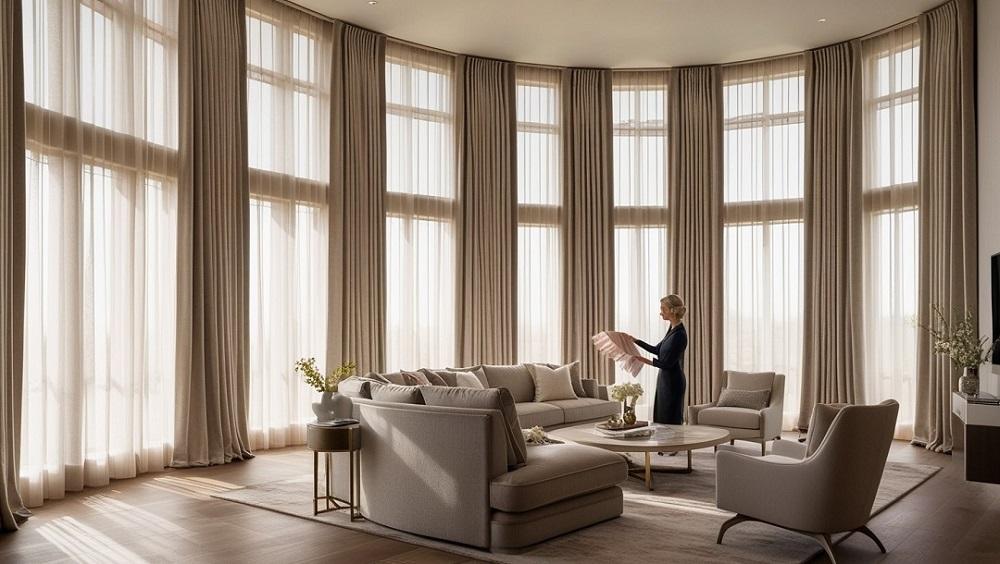Why Custom Fabric Window Treatments Are Perfect for Your Home

Why Custom Fabric Window Treatments Are Perfect for Your Home
Introduction to Custom Fabric Window Treatments
What qualifies as a custom fabric window treatment?
Custom fabric window treatments refer to tailored coverings made specifically to fit a window’s unique dimensions and style requirements. These aren’t standard products pulled from a shelf—they are made-to-measure solutions created to suit the room’s proportions, aesthetics, and light control needs. Each treatment involves a deliberate choice of fabric, header style, lining, and finish, all selected with the client’s objectives in mind.

Bespoke window treatments offer more than a tailored fit. They allow for personal expression in ways that off-the-shelf solutions cannot match. Whether opting for ripple folds, goblet pleats, or soft Roman shades, each element is an opportunity to reinforce a room’s character.
Differences between off-the-shelf and bespoke options
Standard options are produced in fixed dimensions, often in a narrow selection of materials and colours. While convenient, they rarely align with the specific measurements or design intentions of a space. In contrast, custom fabric window treatments are designed from the ground up. They take into account everything from window frame depth to ceiling height, ensuring both visual cohesion and practical function.
One of the standout benefits of custom work lies in the attention to detail. From seamless pattern matching to precise corner pleats, small refinements create a level of finish that mass-produced alternatives cannot replicate. In homes where architectural details and thoughtful styling matter, this distinction is immediately noticeable.
Materials, textures, and design flexibility
Customisation invites a richer selection of materials. Clients may opt for breezy linens in coastal-style kitchens, or dense velvets in formal dining rooms. Each fabric brings its own weight, drape, and interaction with light. Texture plays a powerful role in shaping ambience—matte finishes absorb light for a softer atmosphere, while lustrous fabrics add subtle sheen.
Beyond the fabric itself, trims, tapes, and decorative borders add depth and character. A contrasting edge or elegant tassel can tie together other elements in the room, including upholstery or wall treatments. With this level of flexibility, window coverings transition from purely functional elements to integrated design features.
Aesthetic Versatility for Every Room
Tailoring styles for lounges, kitchens, and bedrooms
Different rooms call for distinct approaches. In lounges, flowing drapes can add drama or softness depending on the desired tone. Bedrooms often require greater light control, favouring layered treatments with blackout linings. Kitchens, with their practical demands, tend to suit relaxed Roman shades or tailored café curtains that bring both charm and usability.
Each space also carries unique challenges. For instance, bay windows require specialised knowledge to create treatments that follow the curve or angles precisely. Sloped ceilings or floor-to-ceiling glass panels demand careful planning. A bespoke solution ensures the treatment enhances the architectural features rather than competing with them.
Matching interior design themes with precision
When working with a defined interior theme—whether it’s mid-century modern, transitional, or rustic—custom treatments allow for exact alignment. Fabrics can echo other finishes, whether that means matching wood stain tones or reflecting metallic accents used in lighting or hardware.
This harmony isn’t always possible with ready-made options. A small mismatch in shade or scale can be visually disruptive. With tailored window coverings, the design story remains consistent throughout the space. It’s this seamless integration that elevates the overall effect.
Colour coordination and visual balance
Window treatments sit at eye level and typically occupy large areas, making their colour selection particularly important. A custom palette allows for subtle layering, whether through tone-on-tone combinations or striking contrasts. It also opens the door to more adventurous choices—such as statement-making patterns or saturated hues—that might be difficult to find ready-made.
Balance also comes into play in the physical sense. The weight of the fabric, the fall of the folds, and the type of header can all affect how grounded or airy the treatment appears. Designers often use this to manipulate the visual proportions of a space, softening high ceilings or adding weight to minimal interiors.
Functionality Meets Design
Light control and privacy without compromise
One of the primary functions of any window treatment is to manage light, but with custom fabric options, the approach becomes more refined. Depending on the selected fabric and lining, it’s possible to gently filter daylight or achieve full blackout. This flexibility ensures rooms can transition from bright and airy during the day to calm and private at night.
In shared spaces, semi-sheer fabrics allow light to enter while obscuring the view from outside. In bedrooms or media rooms, linings can be layered to block light entirely. These solutions also support privacy in urban homes, where neighbouring buildings may be close.
The beauty of custom fabric window treatments lies in their ability to combine functionality with elegance. There’s no need to choose between performance and style—each can enhance the other when handled properly.
Energy efficiency and insulation
Beyond aesthetics and privacy, window treatments play a crucial role in regulating temperature. Fabrics with insulating properties can reduce heat loss in winter and minimise solar gain in summer. This has a noticeable effect on interior comfort and energy bills, particularly in spaces with large or multiple windows.
Heavier weaves like wool blends and velvets are especially effective at reducing draughts and insulating against temperature fluctuations. When combined with blackout or thermal linings, the benefits multiply. These treatments are not only stylish but smart investments in year-round efficiency.
Layering techniques with sheer and blackout options
Layering is a key strength of custom solutions. A double treatment—such as a sheer curtain beneath a heavier drape—offers both flexibility and visual interest. Sheers soften natural light and provide daytime privacy, while the outer layer enhances insulation and blocks light at night.
Roman shades beneath decorative drapery provide similar benefits with a more tailored look. Layering also allows for bolder textile choices; patterned sheers or contrasting linings can be subtly revealed depending on the time of day or how the treatment is arranged.
These combinations lend a dynamic quality to the room, where texture, transparency, and volume shift with the light. It’s an approach that delivers both practicality and visual richness.
The Benefits of Professional Customisation
Measuring and fitting for precision
Accurate measurement is the foundation of any successful window treatment. With custom services, each opening is assessed individually. Factors like uneven sills, non-standard widths, and unique trim details are accounted for, ensuring the finished result fits perfectly.
A professional fitting also prevents common issues like dragging hems, light gaps, or poorly aligned mounts. Attention to these details has a tangible effect on how the treatment sits and functions. There’s a sense of quality and completion that’s difficult to replicate with self-fitted alternatives.
Precise fitting matters especially in older or architecturally distinct homes, where no two windows are exactly alike. A made-to-measure approach respects the individuality of each space.
Integration with motorised and smart home systems
Modern window treatments can be fully integrated with automation systems. Whether using remote controls, voice assistants, or app-based programming, motorisation brings added convenience. Custom fabric treatments can be designed to accommodate this functionality from the start.
Tracks and mechanisms can be discreetly concealed within the header or ceiling recess, preserving the visual integrity of the room. This is especially valuable in open-plan spaces or rooms with large expanses of glass, where manual operation would be impractical.
Smart home integration also allows scheduling based on sunlight patterns or occupancy. This adds a layer of energy efficiency and security, while keeping the aesthetic sharp and streamlined.
Enhancing home value with quality finishes

Beyond immediate comfort and style, custom fabric window treatments contribute to long-term property value. High-quality materials, precise installation, and considered design signal a level of care and investment that buyers notice. They suggest a home that has been thoughtfully maintained and designed.
In a competitive market, these details can influence perceptions. Well-executed window treatments have a permanence and professionalism that mass-market alternatives lack. They turn rooms into polished, complete environments—something increasingly sought after in luxury interiors.
Comparing Fabric Options and Styles
Linen, silk, cotton, and performance fabrics
Different fabrics offer distinct aesthetic and functional advantages. Linen, with its natural texture and organic feel, is ideal for relaxed and informal spaces. It drapes beautifully while allowing light to filter through in soft layers. Silk, by contrast, delivers a more formal finish. Its sheen and fluidity make it a popular choice for traditional or luxurious interiors, although it may require lining to protect against sun damage.
Cotton is one of the most versatile materials, offering a crisp appearance that suits both casual and tailored styles. It takes dyes and prints well, making it perfect for bold colour or pattern. Performance fabrics, meanwhile, combine style with practicality. Designed to resist fading, staining, and moisture, they are ideal in kitchens, bathrooms, or any area where durability is essential.
By selecting the appropriate fabric for each space, homeowners can strike a balance between beauty and practicality, ensuring the treatment serves both decorative and everyday needs.
Trends in pattern and print design
While neutral solids remain timeless, there has been a growing interest in expressive prints. From oversized florals to modern geometrics, patterns are being used to add personality and focal points to interiors. Subtle weaves, tone-on-tone designs, and embroidered motifs offer dimension without overwhelming the room.
Custom fabric window treatments allow for these patterns to be scaled appropriately. A large print that might look awkward on a small window can be resized or replaced with a coordinated trim. Designers often use these details to complement other soft furnishings, creating cohesion across cushions, bedding, or upholstery.
The choice of pattern also reflects lifestyle. Busy households might prefer forgiving textures or small repeats that mask wear. In quieter, formal rooms, more delicate prints can be used to great effect.
Care, cleaning, and maintenance
Maintenance often influences the longevity of any textile. While some fabrics can be dry-cleaned, others are machine-washable or suitable for steam cleaning. Understanding this during the design phase helps clients choose materials aligned with their routines.
Dust and environmental pollutants can build up over time, especially in homes with fireplaces or near busy roads. Linings protect against UV damage and help fabrics retain their colour. Detachable linings or separate sheers are often used in high-traffic areas to extend the lifespan of the decorative layer.
With proper care, custom treatments maintain their appearance for many years. Professional installation also ensures that hooks, cords, and tracks function reliably, reducing wear on the fabric and preventing damage from misuse.
When to Consider Luxury Window Shades Instead
Room-specific advantages
There are occasions when structured shades provide a more suitable solution. In bathrooms and kitchens, for instance, moisture resistance and ease of cleaning are often priorities. Luxury window shades, particularly those made from treated fabrics or composites, handle these conditions well while maintaining an elegant appearance.
In minimalist or modern interiors, shades offer clean lines and minimal bulk. Their tailored look works well in rooms where other design features—such as cabinetry or artwork—take centre stage. When paired with soft valances or side panels, they can still deliver visual warmth.
Comparing fabrics to structured materials
Custom fabric window treatments and shades serve different aesthetic and functional goals. Where fabric drapery offers movement and softness, shades bring control and sleekness. Materials like woven woods, faux silk, or structured linen blends combine textural appeal with structural integrity.
For clients who prefer low-maintenance or minimal profiles, shades may be the preferred choice. They are also more compact when raised, which benefits windows with deep sills or surrounding furniture.
The decision often comes down to lifestyle and preference. Both types offer customisation, but their form and function differ.
Incorporating both in layered treatments
Layering shades with fabric drapery is an increasingly popular approach. A Roman or roller shade can provide privacy and insulation, while side panels in a coordinating fabric add decorative interest. This dual-layer approach combines the strengths of both treatments, improving functionality without sacrificing style.
Designers may use this method to add depth to otherwise flat rooms, or to soften bold architectural features. The result is a balanced, flexible solution that adapts to the room’s changing needs throughout the day.
Why Customisation Outlasts Trends
Timeless designs over temporary trends
Interior design trends shift regularly, but window treatments are not typically replaced as often as cushions or paint. This is where customisation proves its value. By opting for timeless fabrics, classic pleat styles, and neutral colour palettes, homeowners can ensure that their window treatments remain relevant regardless of changing styles.
A carefully selected linen in a natural tone or a subtly patterned Roman shade rarely looks out of place. These choices adapt to evolving furnishings or wall colours, extending the lifespan of the window treatment. Where trends tend to favour quick, seasonal updates, custom solutions focus on long-term harmony with the home’s broader character.
Choosing something timeless doesn’t mean choosing something dull. With custom fabric window treatments, subtle details—like contrast welting or hand-finished hems—add uniqueness without anchoring the design to a specific era.
Futureproofing through quality and flexibility
The adaptability of bespoke window coverings is one of their strongest features. Treatments can be designed with interchangeable linings, double poles for layering, or motorised components that integrate with future smart technologies. These touches make it easier to update or upgrade components without replacing the entire system.
High-quality hardware and professional stitching also reduce the need for repairs or replacements. When each element is chosen with care, from fabric to header style, the result is a solution that performs beautifully across decades. This forward-thinking approach saves time, reduces waste, and supports a more sustainable home environment.
Clients investing in custom fabric window treatments often find they don’t need to revisit their decision for years. The ability to futureproof the treatment both technically and stylistically is key to its enduring appeal.
Long-term satisfaction with tailored solutions
Mass-market options often fall short in meeting all of a homeowner’s needs. Perhaps the length is slightly off, the fabric fades too quickly, or the style doesn’t quite suit the space. Custom treatments resolve these issues from the start. Every choice is intentional and made with the specific room in mind.
Clients often express the most satisfaction with elements they barely notice over time—the gentle fall of a perfect fold, the quiet operation of a well-mounted track, the exact alignment of patterns from panel to panel. These small details accumulate into a feeling of completeness.
Customisation transforms window coverings from an afterthought into a considered feature of the space. The result is not just a good-looking room but one that feels cohesive and finished.
Conclusion: Investing in What Suits Your Space Best
Window treatments are among the most visible design elements in a room, and their impact extends far beyond appearance. They influence comfort, light, privacy, and even energy efficiency. Opting for custom fabric window treatments ensures that every aspect—from fit to finish—is tailored to the homeowner’s lifestyle and space.
In some settings, luxury window shades may offer a better fit. Their clean lines and practical materials serve specific rooms with ease. But for those looking for a personalised, enduring, and stylish solution, custom fabric options remain unmatched.
Each window presents an opportunity. With the right treatment, it becomes a feature, adding beauty, function, and character to the home. Whether dressing a single room or an entire property, thoughtful customisation provides lasting satisfaction.






